1992 年 1 月英语六级真题试卷
Part I Listening Comprehension (20 minutes)
Section A
1.
A) Children learn by example.
B) Children must not tell lies.
C) Children don’t like discipline.
D) Children must control their temper.
2.
A) The man was very happy with his published article.
B) The marking system in the university is excellent.
C) The article was rejected.
D) The article was cut short.
3.
A) He is rude to his students.
B) He is strict with his students.
C) He is kind and often gives good grades.
D) He is strange and hates good students.
4.
A) He is going to China.
B) He is very interested in China.
C) He likes stamps.
D) He likes travelling.
5.
A) Opposite the shoe store.
B) In the middle of a street.
C) At the corner of a street.
D) Right outside the shoe store.
6.
A) The woman cannot go to the party.
B) The man will meet the woman at the party.
C) The woman has not got the invitation yet.
D) The woman will try to go to the party by all means.
7.
A) He wants to have some medicine.
B) The nurse didn’t give him an injection on time.
�
C) The nurse should have shown up at two o’ clock in the morning.
D) He wants to make an appointment with the doctor.
8.
A) Some salad.
B) Some dessert.
C) Just himself.
D) Enough food.
9.
A) They will fail the test.
B) The exam is easy.
C) The grades will be around 40.
D) They might pass the test.
10. A) The woman shouldn’t go to the U.S. with her brother.
B) The woman hasn’t been allowed to be absent from class.
C) The woman can go to the airport to meet her brother.
D) The woman can go and see her brother off.
Section B
Passage One
Questions 11 to 13 are based on the passage you have just heard.
11. A) Because they want to follow the rapidly growing hobby.
B) Because they want to show they are wealthy people.
C) Because they want to hold an exhibition.
D) Because they want to return to the past and to invest money for profit.
12. A) 150,000.
B) 500,000.
C) 250,000.
D) 1,000,000.
13. A) Those which are old and inexpensive.
B) Those which are unique or unusual.
C) Those which are practical.
D) Those which are still fashionable.
Passage Two
�
Questions 14 to 17 are based on the passage you have just heard.
14. A) Because they were ordered to.
B) Because they were in danger.
C) Because the plane was going to fly in circles.
D) Because the plane climbed again.
15. A) Over the airport.
B) Over the land.
C) Over the sea.
D) Over the mountains.
16. A) Because there was something wrong with it.
B) Because the weather changed suddenly.
C) Because there were no lights at the airport.
D) Because too many planes were waiting to take off or land.
17. A) Some time after five.
B) Some time after four.
C) A few minutes before four.
D) A few minutes before six.
Questions 18 to 20 are based on the passage you have just beard.
Passage Three
18. A) People in Venice don’t like walking.
B) The buildings there float on water.
C) Cars are seldom used in Venice.
D) Boat rides there are expensive.
19. A) About four hundred.
B) About seven hundred.
C) Twenty.
D) One hundred and twenty.
20. A) The boats can’t pass under the bridges.
B) The islands will be disconnected.
C) While passing under the bridges, people in the boats have to lower their heads.
�
D) The bridges will be damaged.
Part II Reading Comprehension (35 minutes)
Passage One
Questions 21 to 25 are based on the following passage.
Lecturing as a method of teaching is so frequently under attack today from
educational psychologists and by students that some justification is needed to keep
it. Critics believe that is results in passive methods of learning which tend to be
less effective than those which fully engage the learner. They also maintain that
students have no opportunity to ask questions and must all receive the same content
at the same pace, that they are exposed only to one teacher’s interpretation of subject
matter which will certainly be limited and that, anyway, few lectures rise above
dullness. Nevertheless, in a number of inquiries this pessimistic evaluation of
lecturing as a teaching method proves not to be general among students although they
do fairly often comment on poor lecturing techniques.
Students praise lectures which are clear and orderly outlines in which basic
principles are emphasized but dislike too numerous digressions(离题) or lectures which
consist in part of the contents of a textbook. Students of science subjects consider
that a lecture is a good way to introduce a new subject, putting it in its value as
a period of discussion of problems and possible solutions with their lecturer. They
do not look for inspiration (灵感)—this is more commonly mentioned by teachers—but
arts students look for originality in lectures. Medical and dental students who have
reports on teaching methods, or specifically on lecturing, suggest that there should
be fewer lectures or that, at the least, more would be unpopular.
21. The passage states that ________.
A) few students dislike lecturing as a teaching method
B) lecturing is a good method of teaching
C) lecturing as a teaching method proves to be uninspiring
D) most students like lectures because they can fully engage the learner
22. According to the critics,
A) lectures can’t make students active in their studies
B) some lecturers’ knowledge of their subjects limited
C) most lectures are similar in content
D) few lectures are dull
23. According to this passage, students dislike lectures which ________.
A) introduce mat la[ not included in the textbook
B) present many problems for discussion
�
C) always wander from the subject
D) stress the main points
24. Lecturing as a teaching method is less appreciated by ________.
A) dental teachers
B) medical students
C) arts lecturers
D) science learners
25. According to the author, the evaluation of lecturing as a teaching method by
educational psychologists is ________.
A) defensive
B) conservative
C) realistic
D) negative
Passage Two
Questions 26 to 30 are based on the following passage.
From the moment that an animal is born it has to make decisions. It has to decide
which of the things around it are for eating, and which are to be avoided when to attack
and when to run away. The animal is, in effect, playing a complicated and potentially
very dangerous game with its environment, discomfort or destruction.
This is a difficult and unpleasant business and few animals would survive if they
had to start from the beginning and learn about the world wholly by trial and error,
for there are the have possible decisions which would prove fatal. So we find, in
practice, that the game is always arranged in favour of the young animal in one way
or another. Either the animal is protected during the early stages of its learning about
the world around it, or the knowledge of which way to respond is built into its nervous
system from the start.
The fact that animals behave sensibly can be attributed partly to what we might
call genetic (遗传的) learning, to distinguish it from the individual learning that
an animal does in the course of its own life time. Genetic learning is learning by a
species as a whole, and it is achieved by selection of those members of each generation
that happen to behave in the right way. However, genetic learning depends upon a
prediction that the future will more or less exactly resemble the past. The more variable
individual experience is likely to be, the less efficient is genetic learning as a means
of getting over the problems of the survival game. It is not surprising to find that
very few species indeed depend wholly upon genetic learning. In the great majority of
animals, behaviour is a compound of individual experience and genetic learning to behave
in particular ways.
�
26. According to the first paragraph, the survival game is considered potentially very
dangerous because ________.
A) animals are constantly threatened by attacks
B) wrong decisions will lead to the disappearance of a species
C) decisions made by an animal may turn out to be fatal
D) few animals can survive in their struggle with the environment
27. It is implied but not directly stated in the passage that most animals ________.
A) are likely to make wrong decisions
B) have made correct decisions for their survival
C) depend entirely on their parents in learning about the world around them
D) survive by means of individual learning
28. Genetic learning is effective only if ________.
A) the survival game is arranged in favour of the young animals
B) the animals can adapt themselves to the changing surroundings
C) circumstances remain more or less the same
D) the animals have varied individual experiences
29. The best TITLE for this passage would be ________.
A) The Decision-Making Ability of Animals
B) Survival and Environment
C) Reward and Penalty for Animals
D) Behaviour and Survival
30. How is genetic leaning achieved?
A) It is inherited from animals with keen observation.
B) It is passed down from those animals that behave in the correct way.
C) It is taught to the young generation.
D) It is learned by the new generation through trial and error.
Passage Three
Questions 31 to 35 are based on the following passage.
Scientists, like other human beings, have their hopes and fears, their passions
and disappointments and their strong emotions may sometimes interrupt the course of
clear thinking and sound practice. But science is also self-correcting. The most
fundamental principles and conclusions may be challenged. The steps in a reasoned
argument must be set out for all to see.
�
Experiments must be capable of being carried out by other scientists. The history
of science is full of cases where previously accepted theories have been entirely
overthrown, to be replaced by new ideas which more adequately explain the data.
While there is an understandable inertia-usually lasting about one generation-such
revolution in scientific thought are widely accepted as a necessary and desirable
element of scientific progress. Indeed, the reasoned criticism of a prevailing belief
is a service to the supporters of that belief; if they are incapable of defending it,
they are well-advised to abandon it. This self-questioning and error-correcting aspect
of the scientific method is its most striking property and sets it off from many other
areas of human endeavor, such as religion and fine arts.
The idea of science as a method rather than as a body of knowledge is not widely
appreciated outside of science, or indeed in some corridors inside of science. Vigorous
criticism is constructive in science more than in some other areas of human endeavor
because in it there are adequate standards of validity which can be agreed upon by
competent scientists the world over.
The objective of such criticism is not to suppress but rather to encourage the
advance of new ideas: those which survive a firm skeptical (怀疑的) examination have
a fighting chance of being right, or at least useful.
31. Science is self-correcting because its theories ________.
A) have to be revised constantly to conform with ideas which explain the data better
B) have reflected the most fundamental principles of nature
C) are, more often than not, based on inadequate data
D) must be set out for all to see
32. It can be learned from the context that the word “inertia” (Para. 2, Line 1) most
probably means ________.
A) strong resolution
B) unwillingness to change
C) a period of time
D) prevailing belief
33. The “revolution in scientific thought” (Para. 2, Lind 2) refers to ________.
A) acceptance of the reasoned criticisms of prevailing scientific theories
B) the continuous overthrow of existing scientific theories
C) the adequate explanation of the data in prevailing scientific theories
D) the major discoveries that represent breakthroughs in the history of scientific
progress
34. The author says that the most striking property of the scientific method is its
self-questioning and error-correcting aspect, because it is this aspect that
�
________.
A) is indispensable to the advance of science
B) is most widely appreciated by scientists
C) helps scientists to abandon anything they cannot defend
D) sets science off from many other areas of human endeavor
35. The word “it” (Para. 3, Line 4) refers to “________.”
A) vigorous criticism
B) scientific method
C) human endeavor
D) science
Passage Four
Questions 36 to 40 are based on the following passage.
My father’s reaction to the bank building at 43rd Street and Fifth Avenues in New
York City was immediate and definite: “You won’t catch me putting my money in there!”
he declared. “Not in that glass box!”
Of course, my father is a gentleman of the old school, a member of the generation
to whom a good deal of modern architecture is upsetting, but I am convinced that his
negative response was not so much to the architecture as to a violation of his concept
of the nature of money.
In his generation money was thought of as a real commodity (实物) that could be
carried, or stolen. Consequently, to attract the custom of a sensible man, a bank had
to have heavy walls, barred windows, and bronze doors, to affirm the fact, however untrue,
that money would be safe inside. If a building’s design made it appear impenetrable
the institution was necessarily reliable, and the meaning of the heavy wall as an
architecture symbol dwelt in the prevailing attitude toward money.
But that attitude toward money has of course changed. Excepting pocket money, cash
of any kind is now rarely used; money as a tangible commodity has largely been replaced
by credit.
A deficit (赤字) economy, accompanied by huge expansion, has led us to think of
money as a product of the creative imagination. The banker no longer offers us a safe:
he offers us a service
-a service in which the most valuable element is the creativity for the invention
of large numbers. It is in no way surprising, in view of this change in attitude, that
we are witnessing the disappearance of the heavy-walled hank.
Just as the older bank emphasized its strength, this bank by its architecture boasts
of its imaginative powers. From this point of view it is hard to say where architecture
ends and human assertion (人们的说法) begins.
�
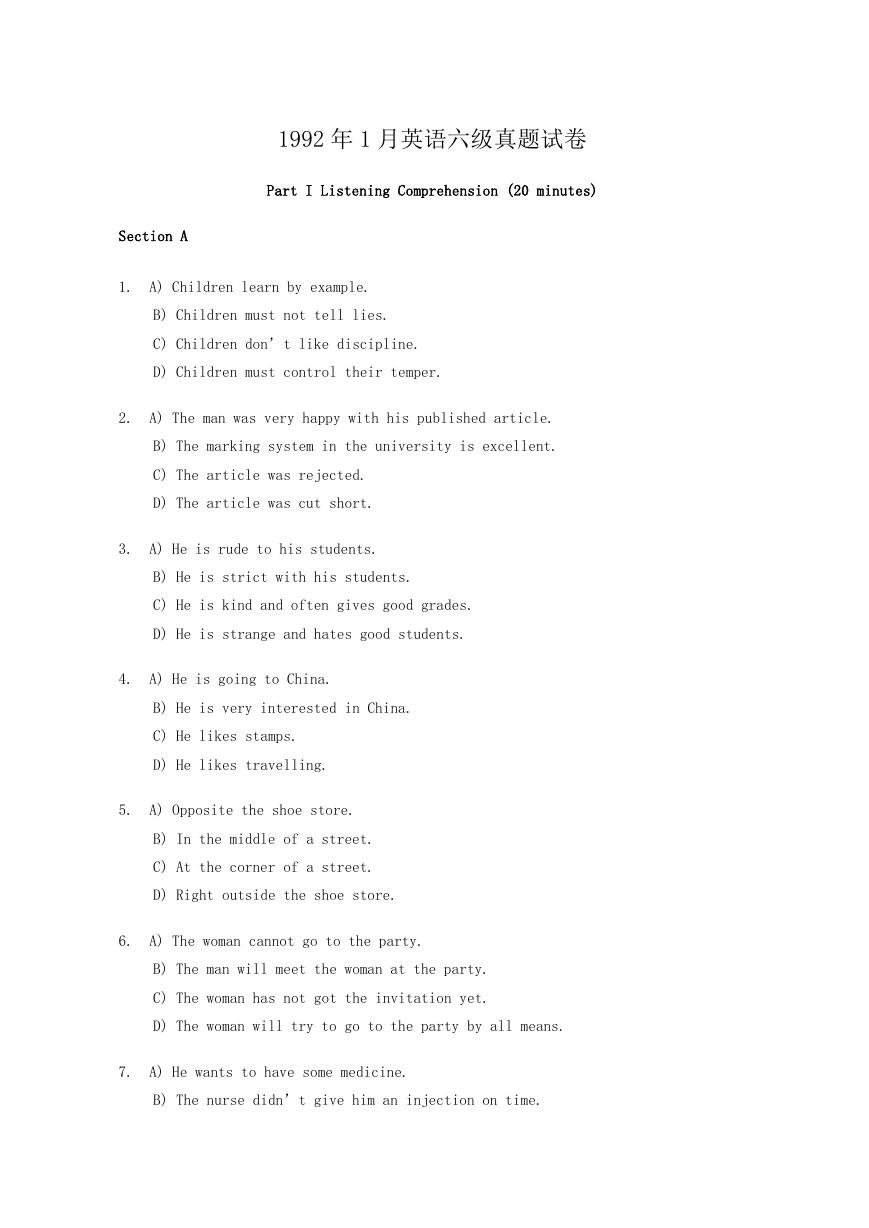
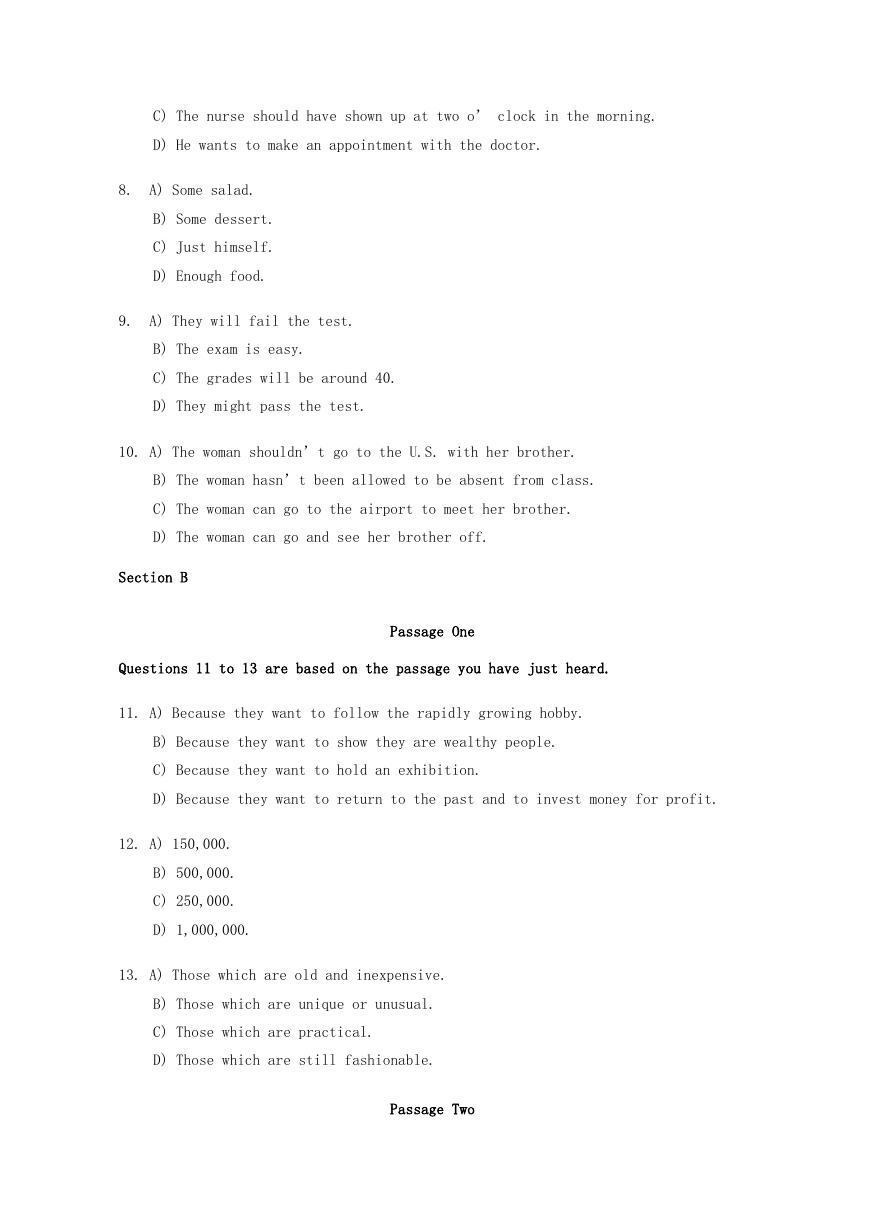
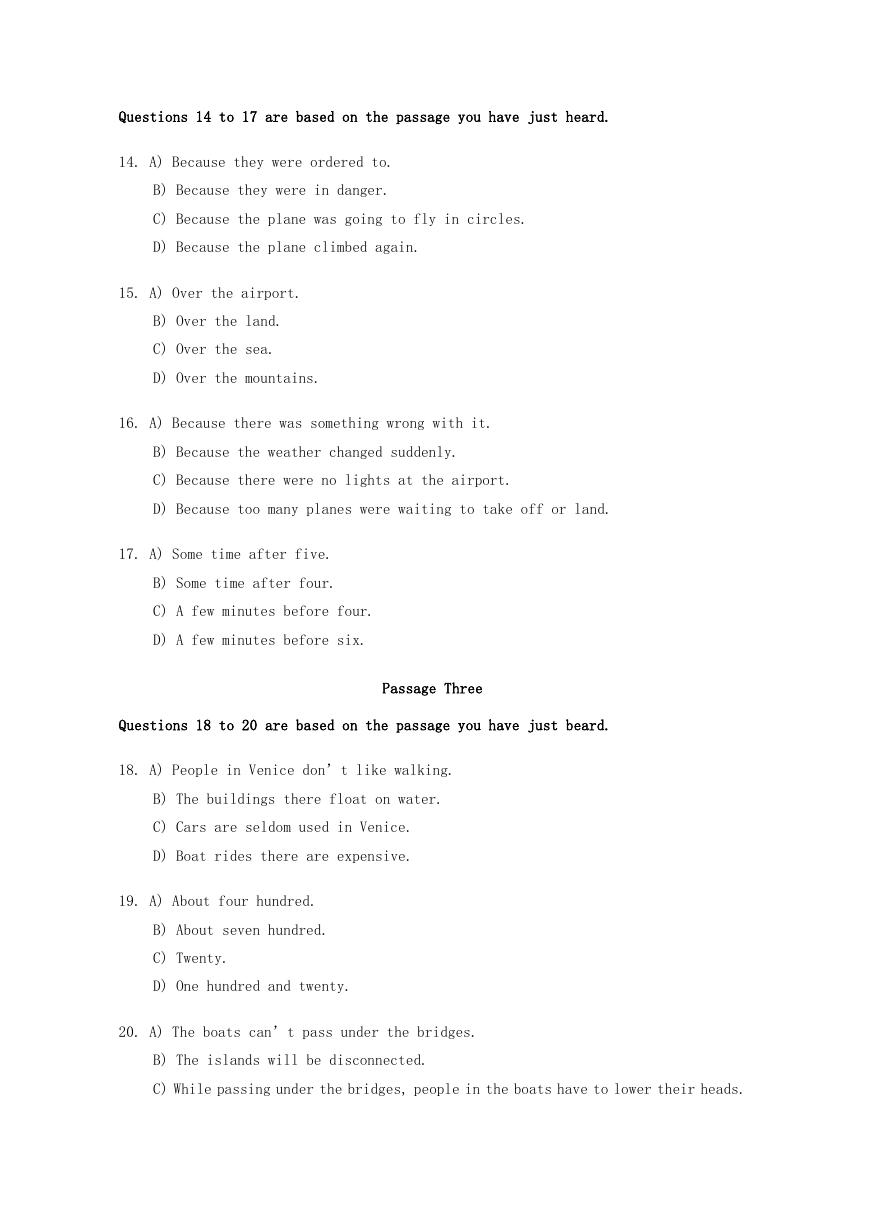
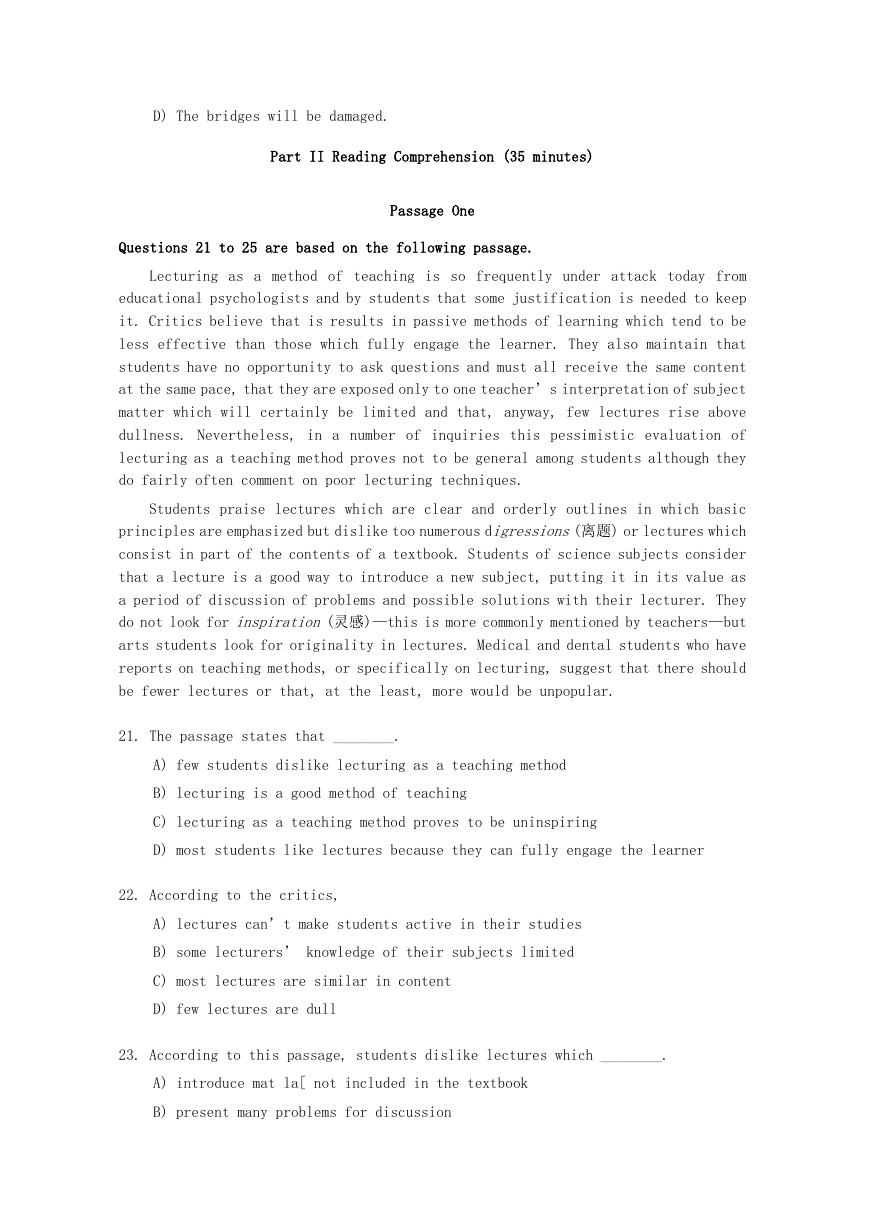
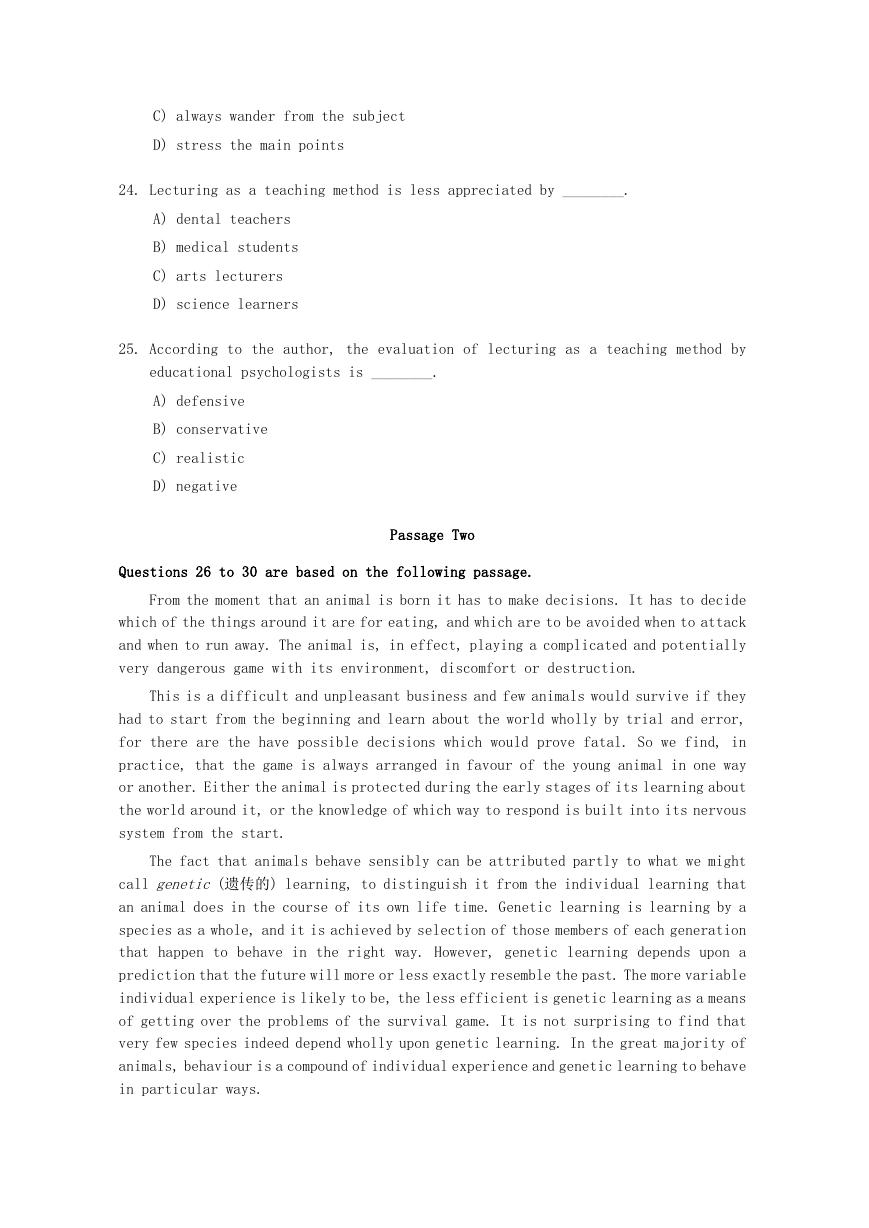
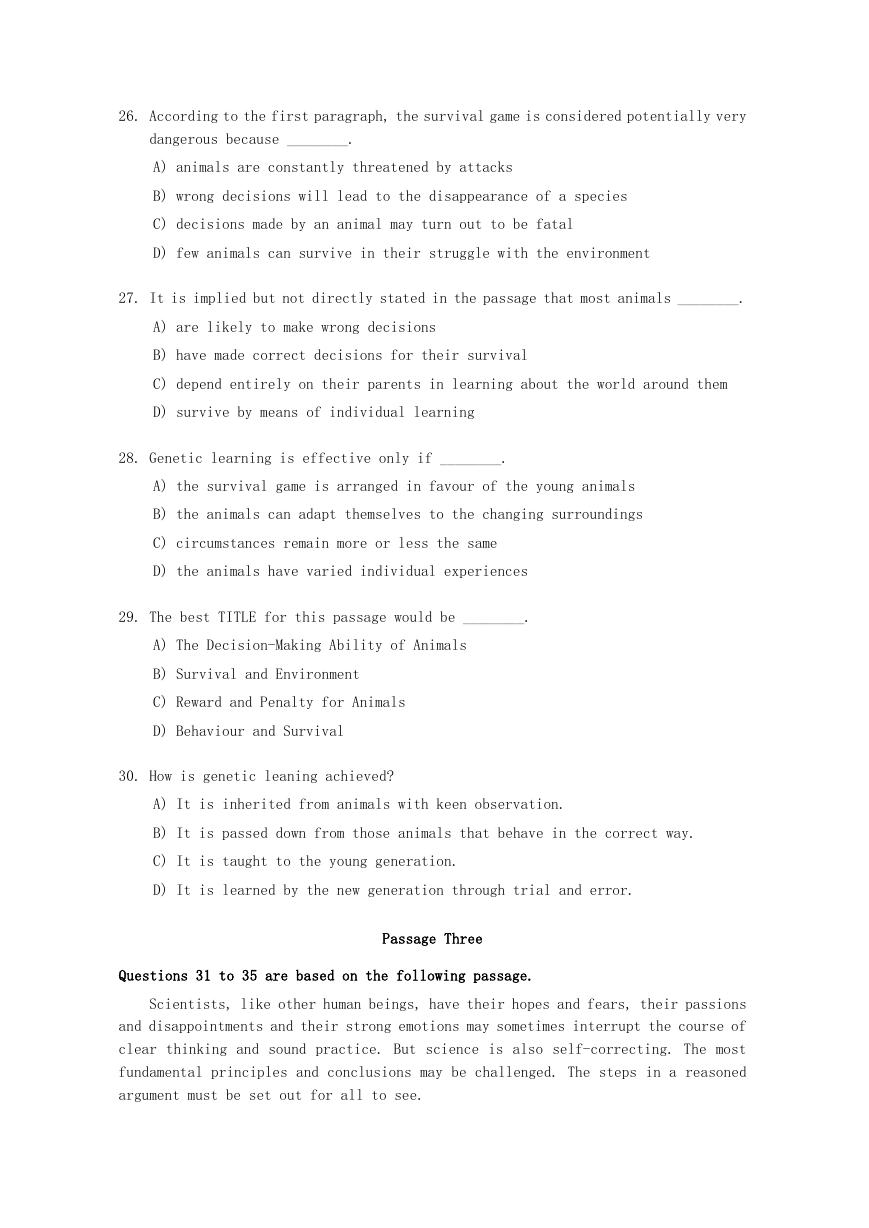
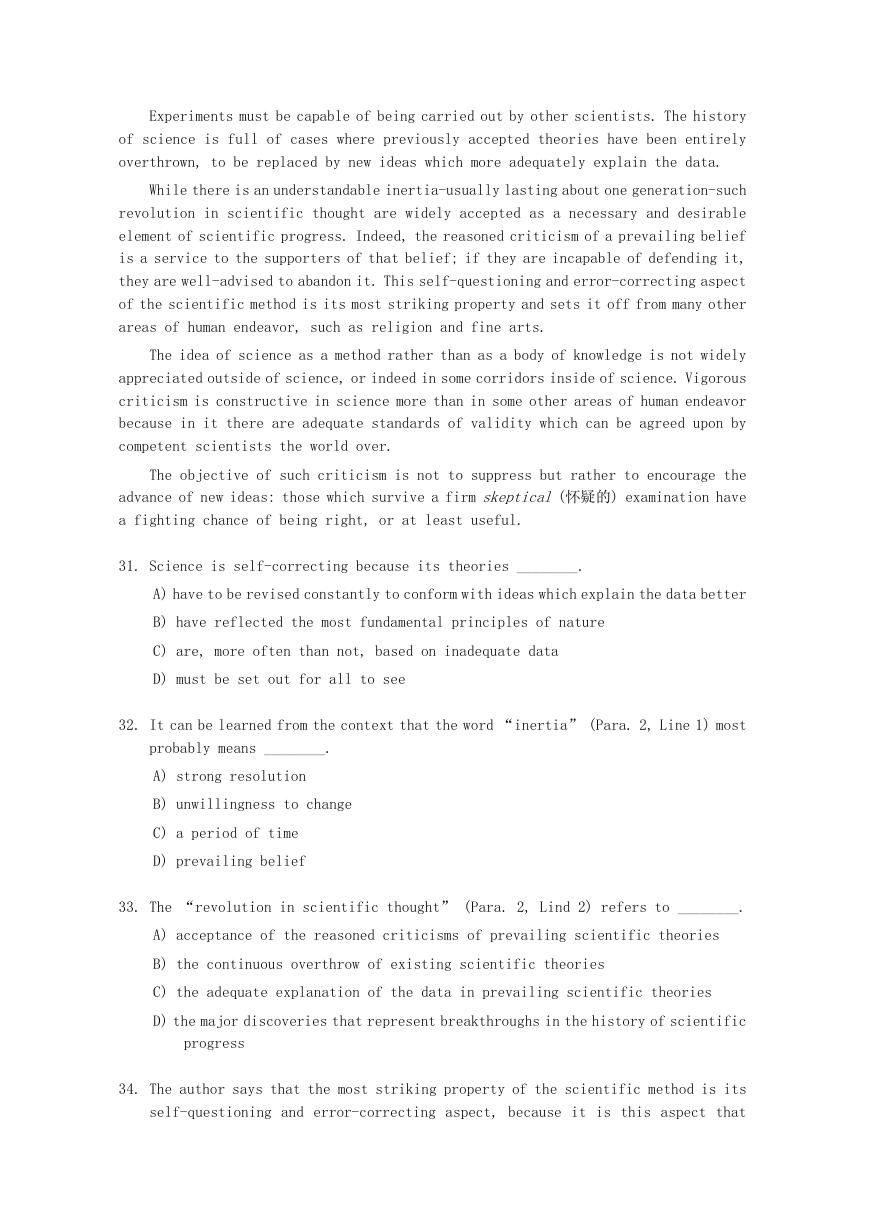
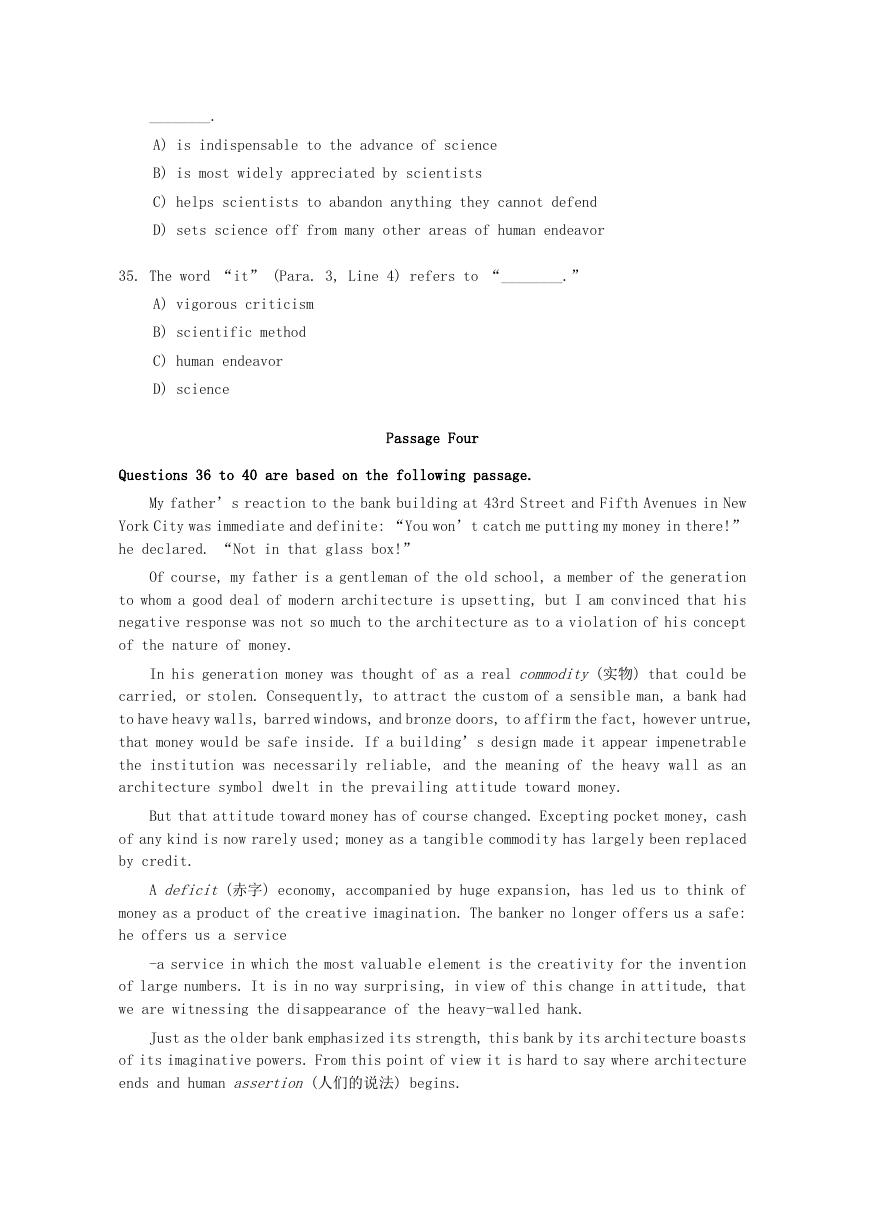








 2023年江西萍乡中考道德与法治真题及答案.doc
2023年江西萍乡中考道德与法治真题及答案.doc 2012年重庆南川中考生物真题及答案.doc
2012年重庆南川中考生物真题及答案.doc 2013年江西师范大学地理学综合及文艺理论基础考研真题.doc
2013年江西师范大学地理学综合及文艺理论基础考研真题.doc 2020年四川甘孜小升初语文真题及答案I卷.doc
2020年四川甘孜小升初语文真题及答案I卷.doc 2020年注册岩土工程师专业基础考试真题及答案.doc
2020年注册岩土工程师专业基础考试真题及答案.doc 2023-2024学年福建省厦门市九年级上学期数学月考试题及答案.doc
2023-2024学年福建省厦门市九年级上学期数学月考试题及答案.doc 2021-2022学年辽宁省沈阳市大东区九年级上学期语文期末试题及答案.doc
2021-2022学年辽宁省沈阳市大东区九年级上学期语文期末试题及答案.doc 2022-2023学年北京东城区初三第一学期物理期末试卷及答案.doc
2022-2023学年北京东城区初三第一学期物理期末试卷及答案.doc 2018上半年江西教师资格初中地理学科知识与教学能力真题及答案.doc
2018上半年江西教师资格初中地理学科知识与教学能力真题及答案.doc 2012年河北国家公务员申论考试真题及答案-省级.doc
2012年河北国家公务员申论考试真题及答案-省级.doc 2020-2021学年江苏省扬州市江都区邵樊片九年级上学期数学第一次质量检测试题及答案.doc
2020-2021学年江苏省扬州市江都区邵樊片九年级上学期数学第一次质量检测试题及答案.doc 2022下半年黑龙江教师资格证中学综合素质真题及答案.doc
2022下半年黑龙江教师资格证中学综合素质真题及答案.doc